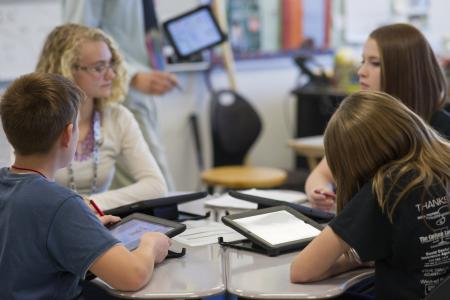Belton Independent School District in Central Texas is relatively small in terms of size; however, it’s big on ideas. It became one of the first districts in Texas to implement a broad mobile technology program – pairing an Apple iPad with each student at South Belton Middle School and Belton High School. Today, Belton ISD hosts administrators and educators from around the nation to share what they’ve learned – best practices that includeinfrastructure, communication to parents, training for teachers and device protection from OtterBox.
|
Recommended Apps – |
|---|
|
A few favorites from the teachers in Belton ISD:
|
When planning started for a new middle school, the district decided to deploy iPads with each of the 735 students enrolled. Access wasn’t necessarily in the cards for all students at South Belton Middle School. The school population consists of a relatively low socio-economic group, with 65 percent of the students receiving free or reduced rate lunches. The vision was to get a tablet device into the hands of every student at the school because greater access means empowerment for the children.
“We wanted this to be a new type of school - a 21st Century School,” said Terice Schneider, instructional technology coordinator for the district. “We want these kids to have the same access as other kids.”
That vision was realized through funding from a bond to purchase the technology, and teachers were instructed to incorporate the devices into everyday learning. Teachers have embraced the new learning tools and view them as a means to empower students to direct their learning.
Seventh grade math teacher Nat Giambalvo recalls the days when he was stuck at a chalkboard, writing lessons and lecturing to his class. Those days are gone. Giambalvo uses apps to write and share his notes from iPad to iPad, to assign and collect homework and to get creative with a subject that has traditionally required a focus on copying formulas rather than facilitating learning through exploration.
“The 1:1 iPads have made it a whole new ballgame,” he said. “The engagement levels are definitely a lot higher. I can send them a video with a lesson and within the lesson is the homework. They don’t realize they are doing homework. I can take the boring math worksheets and incorporate it into a fun project or video. It’s the same work, but now its interactive, and they’re more into it.”
Many South Belton Middle School teachers have reported similar results – increased homework completion because digital worksheets cannot be lost, better one-on-one communication due to email access to teachers, and an overall increase in the a level of excitement about learning. Because of the success at South Belton, the district decided to roll out a 1:1 program at Belton High School as well. Between the two schools, pockets of classroom and 1:1 sets at other locations and those issued to teachers and administrators, Belton ISD has a total of 4,500 iPads deployed.

Without a question, creativity and engagement abound throughout the district. However, when the program was in the early stages of planning there were plenty of questions and few answers. How will content be controlled? Is the IT infrastructure robust enough? What apps should be used?
“The big question was how to protect them,” Schneider said. “In middle school, you’re probably the clumsiest you’ll ever be.”When news of the 1:1 program got out, the district received a number of protective covers to test. Schneider and team created a system to score the characteristics important to them, such as corner and screen protection, access to plugs and ports, etc.
“Some cases feel protective, but you lose some of the functionality. Others allow for full use of the device, but they were not protective. With OtterBox, you get protection and functionality,” she said. “I almost had a heart attack at the beginning when kids would drop these. Students have a hard time sometimes just coming up and down stairs successfully much less carrying things. We’ve had lots of iPads falling downstairs. We had one at the high school that had acid spilled on it. I’ve seen them accidentally tipped off of a counter, and there is no damage at all.”
During the 2012/2013 school year, 86 of the 3,400 1:1 student iPads were damaged or broken for a rate of 2.5 percent. Compared to up to 50 percent reported at some schools and general user breakage rates of around 20 percent reported by an iPad insurance provider SquareTrade, Belton ISD considers their investment well protected and students securely connected.
“Our real goal for this was to not just put technology in the student’s hands but to change the look and feel of instruction in the public school classroom,” Schneider said. “Students are deeply involved in figuring out their own path to learning. They absorb it and connect it to other areas in their lives.”
In backpacks, on desktops and for every drop, ding and bump, OtterBox is helping to keep Belton ISD’s students connected and empowered.
RELATED MATERIALS:
Belton ISD School Case Study Video
PDF VERSION OF CASE STUDY